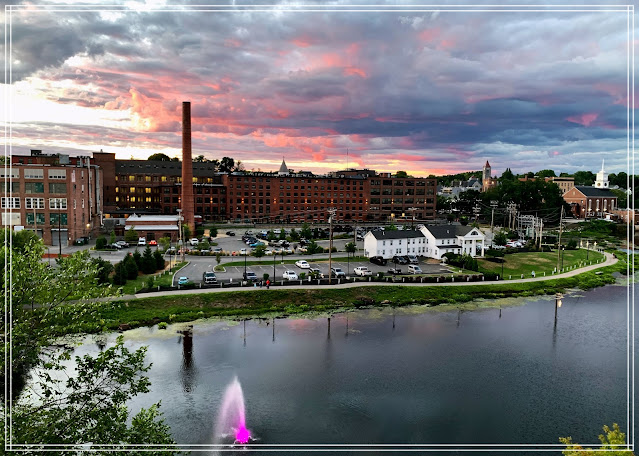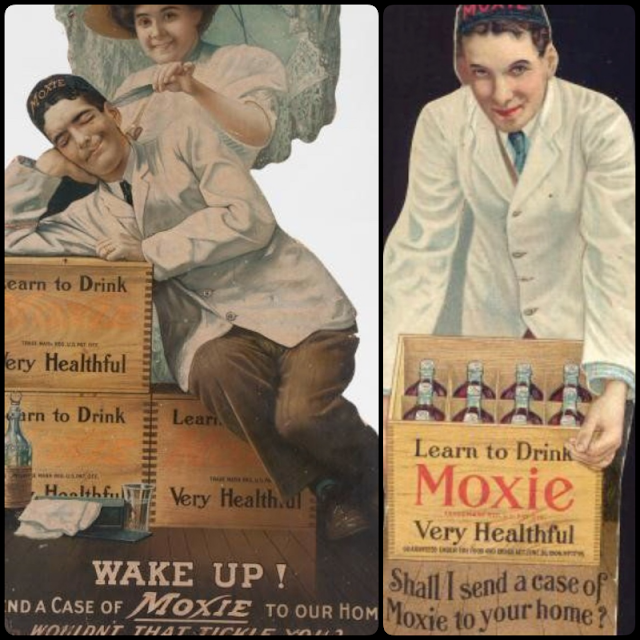These magnificent yachts are currently in two Belfast, ME, shipyards. Most photos are from online sources. Both vessels have long and fascinating histories. After seeing them during our July visit, I had to learn more about them and, of course, wanted to share those details.
This post and a future one are/will be the results. I'm splitting into separate posts as both yachts have long-ish stories. For the record, I'm not necessarily a ship "fan." However, the backstory of both yachts interested me; perhaps, you will also appreciate reading of their storied pasts.
One of these yachts is now in much better shape than the other and ready to sail again.
It's the top one, Cangarda, which is not only one of three steam-powered yachts remaining in the world, the only American-built steam yacht. The other remaining steam yachts are: Medea, a 137-foot luxury steam yacht built in Scotland in 1904, now at the Maritime Museum in San Diego, CA. The oldest, Ena, built in 1900, is at the National Maritime Museum in Australia.
It's now awaiting new ownership as you will read about later. For the right price, you could become its eighth owner. Currently, it resides outside on boat stands and in boat wrap at the Front Street Shipyard in Belfast, ME. We toured the shipyard on an extensive (and free) tour.
Even covered up this yacht is an amazing sight. It's resided at the shipyard after completion of a refit (repairs and maintenance) a few years ago, shortly before the death of its last owner.
This yacht has survived infidelity, war service, service as a houseboat, a sinking, and capsizing on its first voyage after a multi-million dollar restoration. The health of several owners has played a role in the vessel's history as have the New England states of Massachusetts and Maine.
The yacht was hauled from the water and moved into one of the Front Street shipyard's large sheds where it was stripped of its hull paint and repainted, fittings and systems were checked.
 |
| Online source: Cangarda inside Front Street Shipyard |
You wouldn't suspect it from looking at this sleek yacht now, but after years of service at sea, on inland rivers and used in port as a houseboat, Cangarda sank in Boston Harbor (just the hull, details to follow). Rescued and restored, it was back in use as a private yacht, 6 years and $$$ later.
Here's the Backstory
 |
| Canfield & Gardner |
Alas, the couple didn't own their yacht long term—marital infidelity came into play and divorce followed. Cangarda was sold as part of a settlement after Canfield reportedly was found in a compromising situation with a married woman onboard. According to one online story, it was his first and last cruise on the yacht.
 |
| Online source: George Fulford & Magedoma (prev. Cangarda) |
Sold in 1904 for $100,000 to Canadian George Taylor Fulford, a wealthy businessman and member of the Senate of Canada, Cangarda was renamed, Magedoma after his wife and children (Mary, George, Dorothy, Martha) and docked in Brockville, Ontario.
Sadly, this ownership was also short lived at one year. At age 53, Fulford was killed in 1905, when his chauffeured open roadster was sideswiped by a streetcar at a blind intersection in Newton, MA. Ironically, he died in one of the first motor vehicle accidents in North America and was also the first Canadian to die in this way.
Despite his untimely death, the yacht stayed in the family. Mary Fulford, retained ownership until 1941, and the start of WWII when it was lent to the Royal Canadian Navy for use as a cadet navigation training vessel. In 1947, it was returned with a check for $13,000 (equal to about $173,000 today) as compensation for wear and tear incurred during naval service, but hardly enough to cover repair costs.
Third Times the Charm?
 |
| D. Cameron Peck |
Once again, ownership of the yacht was short-term.
In 1952, Peck convinced that he was suffering from a terminal disease (cancer) sold his vintage collection of over 1500 autos and boats, including the yacht. Problems with the IRS may have also been a contributing factor as some sources said that the sales were to hold off bankruptcy. Here's the twist, despite being sure he was dying soon, Peck moved to Arizona—where he overcame his health issues and lived 30 more years.
Here Comes Owners 4 and 5
 |
| Frederick Smith |
A life-long bachelor, he lived aboard boats for 60 years, racing his 104-foot motor-yacht off Miami's shores. After the purchase, he had Cangarda towed to Rochester, NY, moored it at a railroad dock and lived on board for the next 29 years. Smith did routine maintenance and while he kept Cangarda in decent shape, it still needed a full restoration and slowly fell into disrepair.
Smith was described as a retiring, very proper Edwardian gentleman, who always wore a tie and suit jacket, listened to classical music and read the New York Times on board. He was known to host dinner parties in the yacht's lavish living quarters which he decorated with antique furniture. Smith lived aboard Cangarda until he was in his 80's, and relocated to Rochester's University Club for the last years of his life.
 |
| Online source: Cangarda docked in Rochester, NY |
Smith listed the yacht for sale at $150,000, plus a commitment that $750,000 would be spent on its restoration. It sold in 1983 to Richard Reedy who later said he made a deal to pay Smith $1,000 a month for the rest of his life. (Smith died in 1987, at age 86; the same age as the boat he had lived in for so long.)
Reedy of Gloucester, MA, began a major restoration and towed Cangarda to Boston Harbor where it was disassembled. As an amateur, he thought it would take $300,000, but costs piled up s new work surfaced. The wood panelling and other parts were stored in the Boston area. The main and auxiliary steam engines were dismantled and sent to England for refurbishment. (Aside from online sources citing Reedy as the owner who began restoration, there was scant details.)
 |
| Online sources: Cangarda hull capsized in Boston Harbor |
In 2000, the Massachusetts Port Authority was set to scrap the sunken hull when Elizabeth Meyer, the so-called Savior of Classic Yachts, accepted Cangarda as a donation and became owner no. 6. At the time, she helmed J Class Management, a company started in 1998 to restore, preserve, document and manage classic yachts. She had the hull raised and had it stored at Fairhaven Shipyard Companies in MA (the state's largest boatyard), assembled the scattered parts and began looking for a buyer to undertake restoration; asking price—$500,000.
 |
| McNeil on Cangarda |
(FYI this was not Robert McNeil, the Philadelphia chemist, who created Tylenol in 1955. It's also not Robert MacNeil, the Canadian-American journalist, writer and retired TV news anchor who partnered with Jim Lehrer on the The MacNeil/Lehrer Report.)
The hull was unsalvageable after the sinking, so a new one was designed using the latest in laser measurement equipment. In 2004, all of the interior woodworking was shipped on five flatbed trucks to Rutherford’s Boatshop in Richmond, CA, which was known for restoring classic yachts and specialists in marine woodworking The six-year, estimated $12 million restoration ended in 2010. The Victorian interior was reinstalled complete with the Cuban mahogany woodwork. The yacht had the coal-fired boiler switched to an automated diesel-fired system as McNeil planned to cruise Cangarda.
Ready, Set, Launch (almost)
In August 2010, Cangarda was trailered to a launch ramp in Marina Bay, CA, as the first step in returning it to the East coast. After its dual masts were raised (stepped), the yacht was backed down the ramp.
 |
| East Bay Times photo credit |
Whoops—Near disaster as with its stern section afloat and the bow section on the trailer, Cangarda rolled over on its starboard side. The launch crew scrambled to back the trailer further down the ramp to let the bow float free and the ship righted itself, fully afloat in the water. Imagine being the owner and watching this drama play out. (Several onlookers captured this almost catastrophic event on videos available on YouTube with a search for Cangarda Launch. )
All was right after minor repairs were completed and after getting its Certificate of Inspection from the US Coast Guard, Cangarda left California and sailed throughout the U.S. and Canada for the next few years.
 |
| Online source: Cangarda at Front Street Shipyard dock, Belfast, ME |
Why Still in ME?
If you've read this far, it's obvious that Cangarda has not only had quite an interesting 121-year history, but also multiple owners and other mishaps. That trend may continue. In July 2021, Dr. McNeil, the owner who invested heavily in its restoration, passed away from cancer at age 77 in Islesboro, ME; survived by three daughters and two siblings.
Apparently, no family member will continue ownership of Cangarda. If you're in the market for a vintage luxury steam yacht, remember it's only one of three remaining in the world, check out this listing by the UK firm of Sandeman Yacht Company, Ltd.
 |
| Cangarda Listing, Sandeman Yacht Company, Ltd |
Of course, inflation and restoration costs notwithstanding, the price tag is much higher than its original and later resale price — €4,500,000 ($4,574,700 USD) tax not paid. Anyone interested?
The story of the second yacht seen in Belfast, ME, during the same visit, will be posted about at a future date. Spoiler Alert: You may be as surprised as we were on that one's backstory.















































